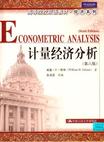计量经济分析
出版时间:2009-9 出版社:中国人民大学出版社 作者:William H. Greene 页数:540
Tag标签:无
前言
《计量经济分析》是计量经济学领域经典的教材之一。这本教材自1990年问世以来,在全球众多高校的中高级计量经济学课程中得到广泛使用.成为计量经济学领域的研究人员不可多得的案头参考资料。近年来,随着计量经济学学科的飞速发展,许多最新的前沿研究成果不断地充实到教材当中。这样,与其他主流的经济学类教材一样,《计量经济分析》从1990年第一版开始至2008年,已经更新到第六版。通读第六版原文,不难发现其内容详尽,资料充实,案例丰富,为读者提供了非常全面的参考素材。而这本经典教材在内容上的不断扩充,也确实彰显了学科的发展速度。但是,在选用教材的过程中,广大教师可能还需要考虑教学学时、教学内容的覆盖面以及教学难度等问题。尤其是在学时安排比较紧凑的情况下,不可能将全书所有内容都进行讲解。同时,学生可能也需要有选择地阅读基本且重要的内容。有鉴于此,《计量经济分析》(第六版)的精编版在完整版的基础上进行了删节,删减的依据是主要保留计量经济学比较基本与核心的重点内容(如最小二乘、广义回归以及重要的模型诊断检验内容等),适当保留部分重要的前沿内容(如面板数据回归的相关内容等)。这样,如果没有足够的时间阅读《计量经济分析》的全书完整版,就可以选择精编版,从而也能体会到这本著作的精髓。这在一定程度上避免了由于教材篇幅过长而可能给读者带来“只见树木不见森林”的问题。当然,在条件和时间允许的情况下,格林的这本经典计量经济学教材的完整版,还是非常值得一读的。对于学生、教师和研究人员来说,选择完整版作为案头必备的参考资料,而选择精编版作为教学和研读的工具,可能会收到更好的效果。
内容概要
《计量经济分析》是计量经济领域“圣经”般的教材。它对计量经济学领域的知识做了全面概述及整合,并且保持及时的更新,因而无论对社会学、医学、环境经济学还是政治学、经济学等领域,都能提供独特的研究视角和方法。 本书可作为社会科学领域本科高年级或研究生学习计量经济学的教材。它有两个目标:一是将学生引入应用计量经济学的殿堂,包括回归分析的基本方法,以及在发现线性模型不充分或不适当时所使用的各种模型;二是向读者充分介绍理论背景,并让读者认识到,这里所学习的一些新模型,就是我们所熟悉的某些模型在同一原理下的自然引申。
作者简介
威廉·H·格林,1976年毕业于美国威斯康星大学麦迪逊分校(University of Wisconsin,Madison),获经济学博士学位。现任美国纽约大学(University of New York)斯特恩商学院(Stern School of Business)经济学教授、丰田汽车讲席教授。曾任教于康奈尔大学,并担任宾夕
书籍目录
第一部分 线性回归模型 第1章 引言 第2章 经典多元线性回归模型 第3章 最小二乘法 第4章 最小二乘估计的统计特性第二部分 广义回归模型 第5章 广义回归模型与异方差 第6章 面板数据模型 第7章 回归方程组第三部分 工具变量与联立方程模型 第8章 工具变量估计 第9章 联立方程模型第四部分 估计方法 第10章 最小距离估计与广义矩估计法 第11章 极大似然估计第五部分 时间序列与宏观计量经济学 第12章 序列相关 第13章 带有滞后变量的回归模型第六部分 横截面、面板数据及微观计量经济学 第14章 离散选择模型 第15章 截断、设限与样本选择附录 实际应用中的数据
章节摘录
插图:We can make a useful distinction between theoretical and applied econometrics. The-orists develop new techniques for estimation and hypothesis testing and analyze theconsequences of applying particular methods when the assumptions that justify thosemethods are not met. Applied econometricians are the users of these techniques andthe analysts of data ("real world" and simulated). Of course, the distinction is farfrom clean; practitioners routinely develop new analytical tools for the purposes ofthe study that they are involved in. This book contains a large amount of economet-ric theory, but it is directed toward applied econometrics. I have attempted to surveytechniques, admittedly some quite elaborate and intricate, that have seen wide use "inthe field."Another useful distinction can be made between microeconometrics and macro-econometrics. The former is characterized largely by its analysis of cross section andpanel data and by its focus on individual consumers, firms, and micro-level decisionmakers. Macroeconometrics is generally involved in the analysis of time-series data,usually of broad aggregates such as price levels, the money supply, exchange rates,output, investment, and so on. Once again, the boundaries are not sharp. The very largefield of financial econometrics is concerned with long time-series data and occasionallyvast panel data sets, but with a very focused orientation toward models of individualbehavior. The analysis of market returns and exchange rate behavior is neither macro-nor microeconometric, or perhaps it is some of both. Another application that we willexamine in this text concerns spending patterns of municipalities, which, again, restssomewhere between the two fields.Applied econometric methods will be used for estimation of important quantities,analysis of economic outcomes, markets or individual behavior, testing theories, and forforecasting. The last of these is an art and science in itself, and (fortunately) the subjectof a vast library of sources. Although we will briefly discuss some aspects of forecasting,our interest in this text will be on estimation and analysis of models. The presentation,where there is a distinction to be made, will contain a blend of microeconometric andmacroeconometric techniques and appications. The first 11 chapters of the book arelargely devoted to results that form the platform of both areas. Chapters 12 to 13 focuson time series modeling while Chapters 14 to 15 are devoted to methods more suitedto cross sections and panels, and methods used more frequently in microeconometrics.We will not be spending any time on financial econometrics. For those with an interestin this field, I would recommend the celebrated work by Campbell, Lo, and Mackinlay(1997) and, for a more time-series-oriented approach, Tsay (2005). It is also necessaryto distinguish between time-series analysis (which is not our focus) and methods thatprimarily use time-series data. The former is, like forecasting, a growth industry servedby its own literature in many fields. While we will employ some of the techniques oftime-series analysis, we will spend relatively little time developing first principles.The techniques used in econometrics have been employed in a widening vari-ety of fields, including political methodology, sociology [see, e.g., Long (1997) andDeMaris (2004)], health economics, medical research (how do we handle attrition frommedical treatment studies?) environmental economics, transportation engineering, andnumerous others. Practitioners in these fields and many more are all heavy users of thetechniques described in this text.
编辑推荐
《计量经济分析(第6版)》对计量经济学领域的知识做了全面概述及整合,并且保持及时的更新,因而无论对社会学、医学、环境经济学还是政治学、经济学等领域,都能提供独特的研究视角和方法。
图书封面
图书标签Tags
无
评论、评分、阅读与下载
用户评论 (总计22条)
- 因为这本教材较深入讲计量经济学,所以要买古扎拉蒂的基础计量经济学才行
- 基本计量学教材,想深入的买高级计量学
- 非常不错,经典。应该有一本。
- 原来是全英的,震惊了,希望读起来不会有太大压力
- 送货比平时慢,不过可以理解。就是书面上有好多尘土。。要是像亚马逊一样有层层包装就好了
- 同学买的听说还不错。
- 学计量 必读国外教材
- 书的质量很好,与描述的一样,可以继续购买。
- 觉得不错啦~~
送货也很快~~有些内容还是有删节~~
总体还好~~ - 光看了封皮,以为是汉语的呢,不过教材本身很经典
- 中文都看不懂,看什么英文呢。。。我想退货!!!
- 这本书比原作删了近一半,被坑了,我还以为字小呢
- 总体不错,不过书中有些错误
- 这本书 给 五颗星原因如下:格林的这本书 原教材在编排上面 难易前后把握不准 所以如果自学的话当教材不是很理想这本书保留了 格林经典部分的论述虽为阉割版 但很值得中文版太贵 99元! 而且近百页内容 都是人名录 个人觉得不值得买 ....建议与 伍德里奇 的 中文版 配合着用能达到互补的作用这本书很便宜 质量也很不错值得拥有
- 确实少了很多内容
- 用处不大~不适合自学或初学
- 书很好 ,应该是正版了,尽管运输过程中,有褶皱,破算,但是从包装来看,是很用心的。内容不用说了,不然买它何用。
- 还纳闷为什么这么便宜,原来是阉割版的,重要的几章都有,对于初学者是完全够用的
- 原版的书籍还好,但是非常专业,就本科阶段来讲,能看个大概就已经很不错了,理论比较精深,但是改编的感觉还是有点不那么“原汁原味”。
- 原著1200多面,现在只剩下500多面了,悲剧
- 前几天收到的货,付了40.7元,现在都只要35元左右了。早知这样,宁肯晚几天再买书。而且,这书是一个精编版,和原书一对比,发现少了近一半的内容。真不爽
- 那个人注释过贾奇的那本书,很差
相关图书
- 编辑的艺术
- 心学之思
- 中国近代会党史研究
- 明清福建家族组织与社会变迁
- 医学科研方法与论文写作
- 精编临床神经眼科学
- 清宫医案集成(上下册)
- 保健食品功效成分检测技术与方法
- 维生素矿物质补充剂在疾病防治中的临床应用
- 癌症的预防与早期发现
- 美术高考速写冲刺
- 国家标准腧穴名称与定位挂图
- 红外热像技术临床应用图析
- 实用中医风湿病学
- 美术高考速写基础图解
- 冲刺三大美院训练方法.色彩静物 A
- 2010全国硕士研究生入学统一考试西医综合全真模拟试题
- 素描人物-A
- 素描人物头像线面造型训练精解
- 色彩静物灰色调训练精解
- 家畜性别控制技术
- 动物尺寸控制
- 油田硫酸盐还原菌分子生态学及其活性生态调控研究
- 特发性血小板减少性紫癜(DVD)
- 色彩静物小色稿训练精解
